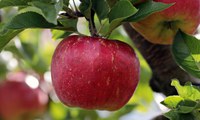Dakota Gardener: Apple tree identification — mystery solved!
(Click an image below to view a high-resolution image that can be downloaded)
By Tom Kalb, Horticulturist
NDSU Extension
Every fall, lots of people bite into an apple and fall in love. The flavors, juices and crunch of the fruit are all amazing. It is a classic case of love at first bite.
Sometimes the apple comes from a tree on an old farm. Sometimes the apple comes from a friend’s tree. Sometimes the apple comes from a tree in someone’s own yard, planted before they moved in.
These people love the tree but don’t always know what variety it is. They want another tree just like it. The gardeners send me photos or give me samples and ask me to tell them what variety of apple it is.
Unfortunately, there are hundreds of different apple varieties. It’s almost impossible to look at an apple and say what variety it is.
These people need to hire an apple tree detective, but where can you find one?
I know the perfect place.
Washington State University offers a kit that allows you to take “fingerprints” from the tree you want to identify. It is an ancestry test, and it's available at MyFruitTree.org.
For $50, the organization will send you a DNA test kit. You snip some young leaves from the tree, place them into the special tubes provided and mail them to the lab.
The lab has a database of thousands of apple trees. Maybe the scientists will find an exact match and tell you what variety you have. This is perfect! Your tree’s identity has been solved, and you can buy another tree just like it.
Maybe the results will not have an exact match of your tree but will describe some of its ancestry. Perhaps the tree’s ancestors are famous for Russian apple pies or New England cider. The possibilities and legends are endless.
Maybe the results will reveal that you have a one-of-a-kind wild seedling. That tree has its own special story to tell.
Once the tree is identified, you can make plans to plant an identical tree like that at your home. If it is a named variety, you can buy the tree from a nursery.
If it is not a named variety, you can create an identical tree by grafting it. You can take cuttings of branch tips from the tree this winter, store them in a refrigerator and graft them onto an apple tree or rootstock in early spring. Rootstocks are sold by fruit tree nurseries during winter. There are lots of videos online that show how to graft apple trees. It’s a simple and straightforward operation.
If you have a special apple tree in your life, its ancestry is ready to be discovered. You can become an apple tree detective by going to MyFruitTree.org.
For more information about gardening, contact your local NDSU Extension agent. Find the Extension office for your county at www.ndsu.edu/agriculture/extension/county-extension-offices.
NDSU Agriculture Communication – Nov. 18, 2025
Source: Tom Kalb, 701-877-2585, tom.kalb@ndsu.edu
Editor: Dominic Erickson, 701-231-5546, dominic.erickson@ndsu.edu




